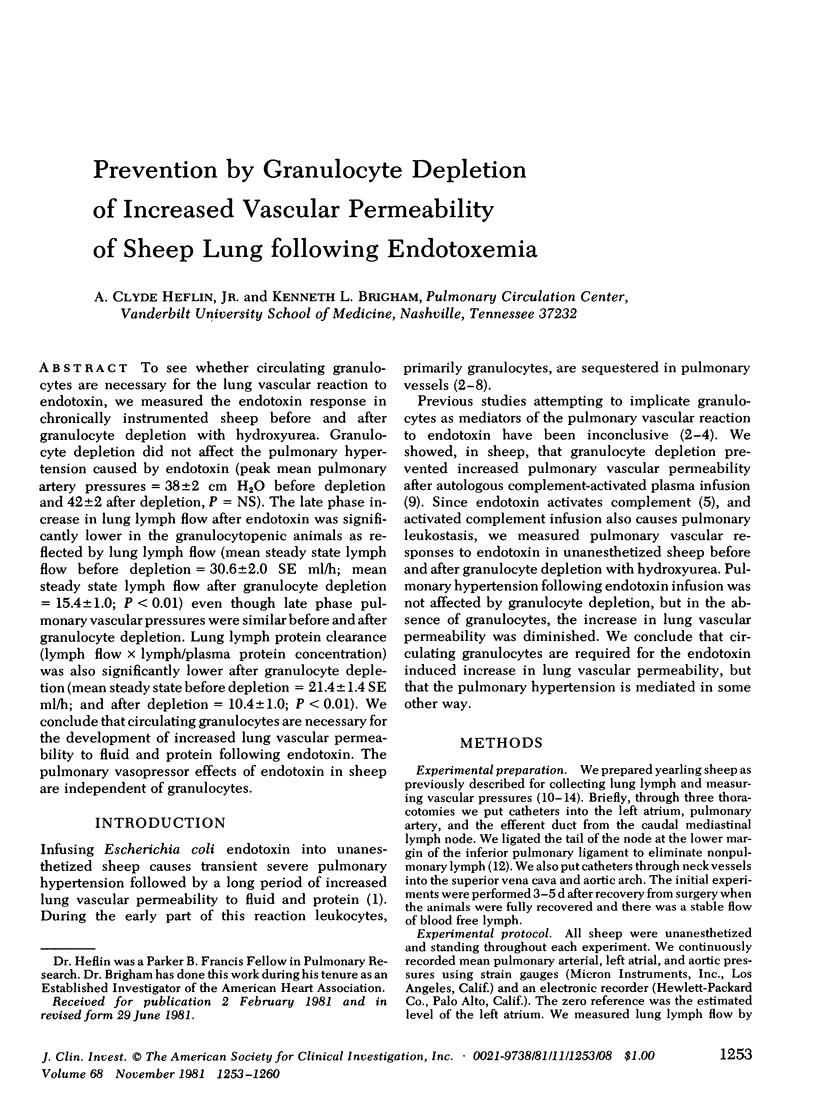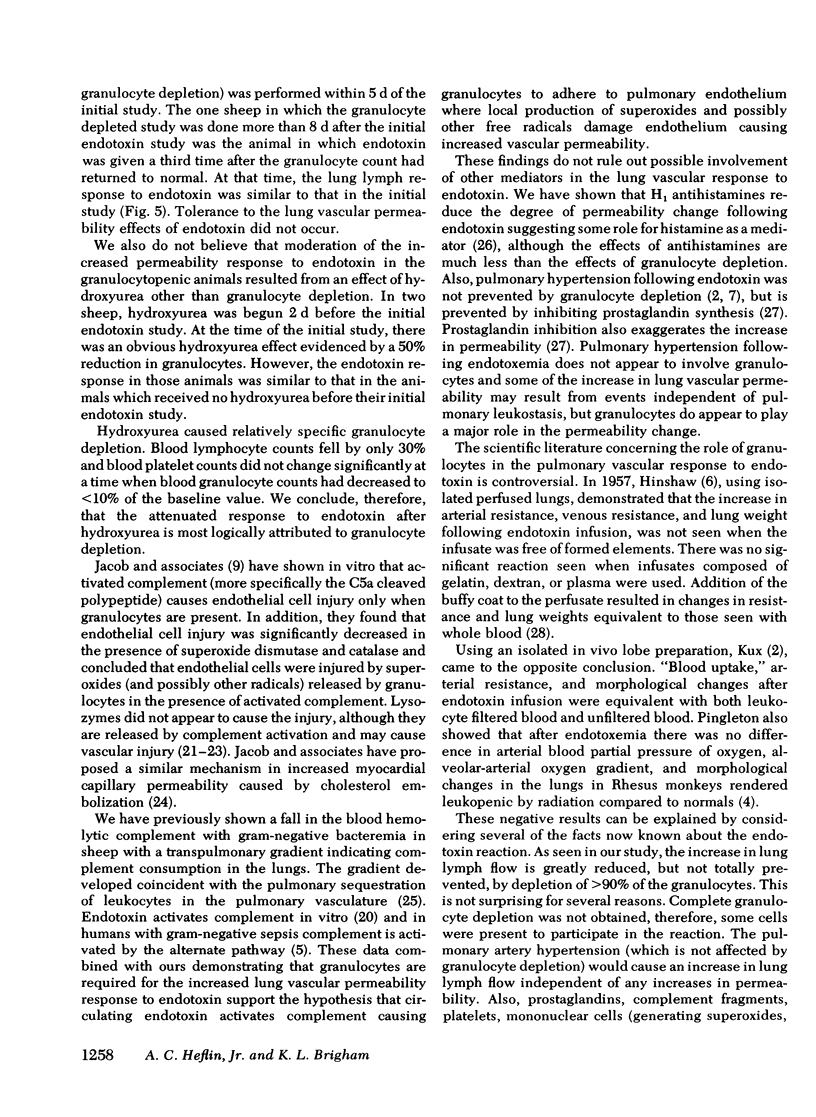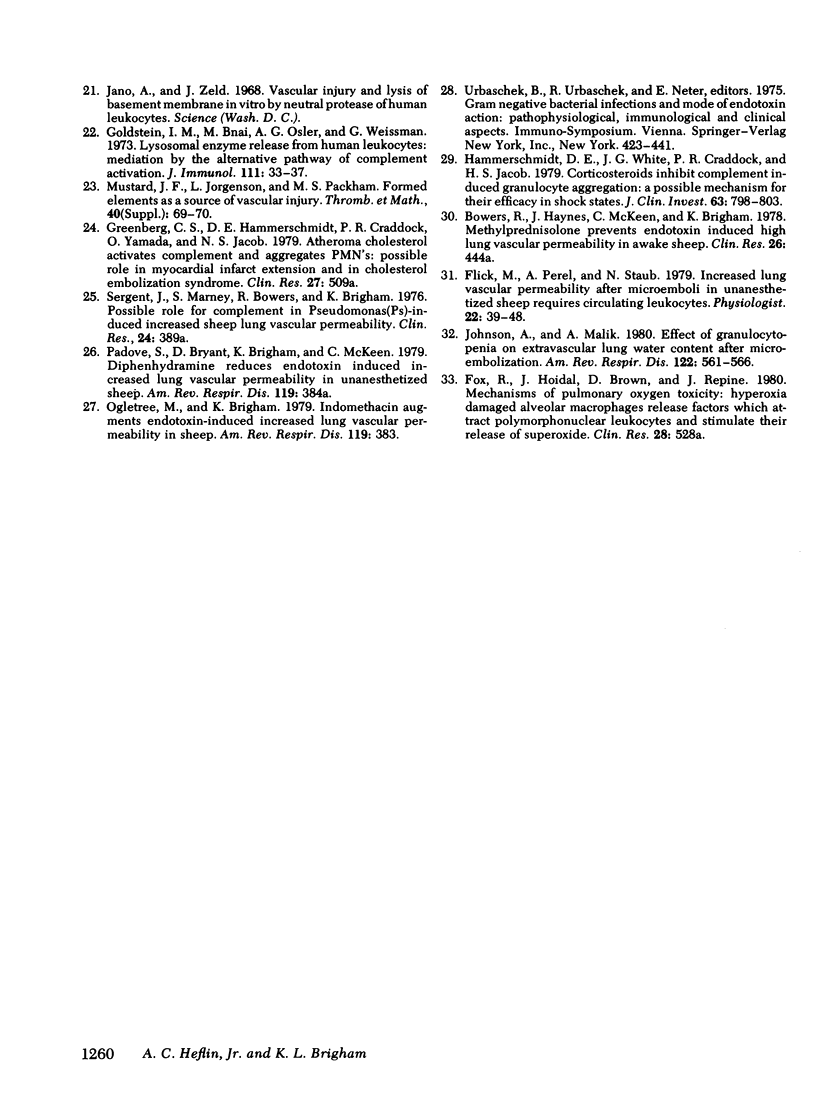Abstract
To see whether circulating granulocytes are necessary for the lung vascular reaction to endotoxin, we measured the endotoxin response in chronically instrumented sheep before and after granulocyte depletion with hydroxyurea. Granulocyte depletion did not affect the pulmonary hypertension caused by endotoxin (peak mean pulmonary artery pressures = 38 +/- 2 cm H2O before depletion and 42 +/- 2 after depletion, P = NS). The late phase increase in lung lymph flow after endotoxin was significantly lower in the granulocytopenic animals as reflected by lung lymph flow (mean steady state lymph flow before depletion = 30.6 +/- 2.0 SE ml/h; mean steady state lymph flow after granulocyte depletion = 15.4 +/- 1.0; P less than 0.01) even though late phase pulmonary vascular pressures were similar before and after granulocyte depletion. Lung lymph protein clearance (lymph flow x lymph/plasma protein concentration) was also significantly lower after granulocyte depletion (mean steady state before depletion = 2.14 +/- 1.4 SE ml/h; and after depletion = 10.4 +/- 1.0; P less than 0.01). We conclude that circulating granulocytes are necessary for the development of increased lung vascular permeability to fluid and protein following endotoxin. The pulmonary vasopressor effects of endotoxin in sheep are independent of granulocytes.
Full text
PDF







Selected References
These references are in PubMed. This may not be the complete list of references from this article.
- Brigham K. L., Bowers R., Haynes J. Increased sheep lung vascular permeability caused by Escherichia coli endotoxin. Circ Res. 1979 Aug;45(2):292–297. doi: 10.1161/01.res.45.2.292. [DOI] [PubMed] [Google Scholar]
- Brigham K. L., Owen P. J., Bowers R. E. Increased permeability of sheep lung vessels to proteins after Pseudomonas bacteremia. Microvasc Res. 1976 May;11(3):415–419. doi: 10.1016/0026-2862(76)90067-4. [DOI] [PubMed] [Google Scholar]
- Brigham K. L., Owen P. J. Increased sheep lung vascular permeability caused by histamine. Circ Res. 1975 Nov;37(5):647–657. doi: 10.1161/01.res.37.5.647. [DOI] [PubMed] [Google Scholar]
- Brigham K. L., Woolverton W. C., Blake L. H., Staub N. C. Increased sheep lung vascular permeability caused by pseudomonas bacteremia. J Clin Invest. 1974 Oct;54(4):792–804. doi: 10.1172/JCI107819. [DOI] [PMC free article] [PubMed] [Google Scholar]
- Coalson J. J., Hinshaw L. B., Guenter C. A. The pulmonary ultrastructure in septic shock. Exp Mol Pathol. 1970 Feb;12(1):84–103. doi: 10.1016/0014-4800(70)90077-8. [DOI] [PubMed] [Google Scholar]
- Craddock P. R., Fehr J., Brigham K. L., Kronenberg R. S., Jacob H. S. Complement and leukocyte-mediated pulmonary dysfunction in hemodialysis. N Engl J Med. 1977 Apr 7;296(14):769–774. doi: 10.1056/NEJM197704072961401. [DOI] [PubMed] [Google Scholar]
- Erdmann A. J., 3rd, Vaughan T. R., Jr, Brigham K. L., Woolverton W. C., Staub N. C. Effect of increased vascular pressure on lung fluid balance in unanesthetized sheep. Circ Res. 1975 Sep;37(3):271–284. doi: 10.1161/01.res.37.3.271. [DOI] [PubMed] [Google Scholar]
- Fearon D. T., Ruddy S., Schur P. H., McCabe W. R. Activation of the properdin pathway of complement in patients with gram-negative of bacteremia. N Engl J Med. 1975 May 1;292(18):937–940. doi: 10.1056/NEJM197505012921802. [DOI] [PubMed] [Google Scholar]
- Gaynor E. The role of granulocytes in endotoxin-induced vascular injury. Blood. 1973 Jun;41(6):797–808. [PubMed] [Google Scholar]
- Gewurz H., Shin H. S., Mergenhagen S. E. Interactions of the complement system with endotoxic lipopolysaccharide: consumption of each of the six terminal complement components. J Exp Med. 1968 Nov 1;128(5):1049–1057. doi: 10.1084/jem.128.5.1049. [DOI] [PMC free article] [PubMed] [Google Scholar]
- Goldstein I. M., Brai M., Osler A. G., Weissmann G. Lysosomal enzyme release from human leukocytes: mediation by the alternate pathway of complement activation. J Immunol. 1973 Jul;111(1):33–37. [PubMed] [Google Scholar]
- Hammerschmidt D. E., White J. G., Craddock P. R., Jacob H. S. Corticosteroids inhibit complement-induced granulocyte aggregation. A possible mechanism for their efficacy in shock states. J Clin Invest. 1979 Apr;63(4):798–803. doi: 10.1172/JCI109365. [DOI] [PMC free article] [PubMed] [Google Scholar]
- Hsu C. C., Wu S. J., Celic L., Weaver L. J., Solliday N. Increased proportion of active sheep erythrocyte rosette-forming lymphocytes and plasma rosette enhancement in sarcoidosis. Am Rev Respir Dis. 1979 Mar;119(3):383–389. doi: 10.1164/arrd.1979.119.3.383. [DOI] [PubMed] [Google Scholar]
- Johnson A., Malik A. B. Effect of granulocytopenia on extravascular lung water content after microembolization. Am Rev Respir Dis. 1980 Oct;122(4):561–566. doi: 10.1164/arrd.1980.122.4.561. [DOI] [PubMed] [Google Scholar]
- Nicolaysen G., Nicolaysen A., Staub N. C. A quantitative radioautographic comparison of albumin concentration in different dized lymph vessels in normal mouse lungs. Microvasc Res. 1975 Sep;10(2):138–152. doi: 10.1016/0026-2862(75)90002-3. [DOI] [PubMed] [Google Scholar]
- Staub N. C., Bland R. D., Brigham K. L., Demling R., Erdmann A. J., 3rd, Woolverton W. C. Preparation of chronic lung lymph fistulas in sheep. J Surg Res. 1975 Nov;19(5):315–320. doi: 10.1016/0022-4804(75)90056-6. [DOI] [PubMed] [Google Scholar]
- Staub N. C. Pulmonary edema. Physiol Rev. 1974 Jul;54(3):678–811. doi: 10.1152/physrev.1974.54.3.678. [DOI] [PubMed] [Google Scholar]
- Vreim C. R., Snashall P. D., Demling R. H., Staub N. C. Lung lymph and free interstitial fluid protein composition in sheep with edema. Am J Physiol. 1976 Jun;230(6):1650–1653. doi: 10.1152/ajplegacy.1976.230.6.1650. [DOI] [PubMed] [Google Scholar]


